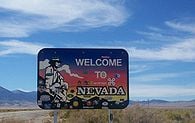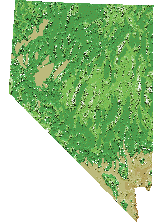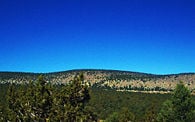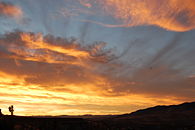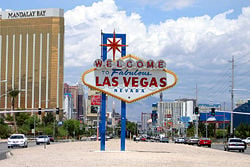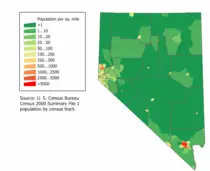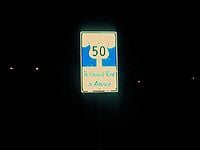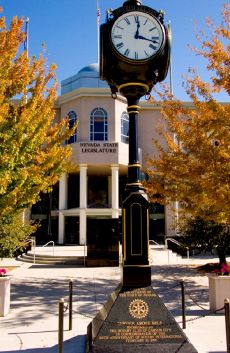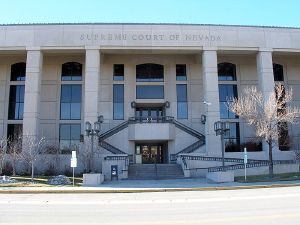Nevada
Template:US state Nevada is a state located in the western region of the United States of America. The capital is Carson City and the largest city is Las Vegas. The state's nickname is "The Silver State" due to the large number of silver deposits that were discovered and mined there.
Nevada is the seventh-largest state in area, and about 86 percent of the land is owned by the U.S federal government under various jurisdictions, both civilian and military.[1] As of 2006, there were about 2.6 million residents, with over 85 percent of them residing in the metropolitan areas around Las Vegas and Reno.[2] The state is well known for its easy marriage and divorce proceedings, legalization of gambling and, in a few counties, legalized brothels.
The local pronunciation of the state's name is not /nɨˈvɑːdə/ (as in the "a" in "father"), but /nɨˈvæːdə/ (as in the "a" in "glad").Cite error: Closing </ref> missing for <ref> tag
Geography
Nevada is bordered by Utah to the east, Arizona to the southeast, California on the west, Oregon to the northwest, and Idaho to the northeast.
Nevada is broken up by many north-south mountain ranges. Most of these ranges have inland-draining (unconnected to the ocean by waterways) valleys between them.
Much of the northern part of the state is within the Great Basin Desert, a mild desert that experiences hot temperatures in the summer and sub-freezing temperatures in the winter. Occasionally, moisture from the Arizona Monsoon will cause summer thunderstorms; Pacific storms may blanket the area with snow. The state's highest recorded temperature was 125 °F (52 °C) in Laughlin (elevation of 605 feet (184 m)) on June 29, 1994.[3]
The Humboldt River crosses from east to west across the northern part of the state, draining into the Humboldt Sink near Lovelock. Several rivers drain from the Sierra Nevada eastward, including the Walker, Truckee, and Carson rivers.
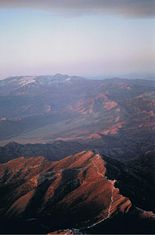
The mountain ranges, some of which have peaks above 13,000 feet (4,000 m), harbor lush forests high above desert plains, creating sky islands for endemic species. The valleys are often no lower in elevation than 3,000 feet (900 m).
The eastern parts of the state receive more summer moisture and have a slightly more verdant terrain. Sagebrush grows everywhere, and in some places rivers and streams break the desert terrain.
The southern third of the state, where Las Vegas is situated, is within the Mojave Desert. The area receives less rain in winter but is closer to the Arizona Monsoon in summer. The terrain is also lower, mostly below 4,000 feet (1,200 m), creating conditions for hot summer days and cool to chilly winter nights due to inversion.
The largest mountain range in the southern portion of the state is the Spring Mountains, just west of Las Vegas. The state's lowest point is along the Colorado River, south of Laughlin.
History
Before 1861
The Comstock Lode was the first major U.S. deposit of silver ore, discovered under what is now Virginia City, Nevada on the eastern slope of Mt. Davidson, a peak in the Virginia range. After the discovery was made public in 1859, prospectors rushed to the area and scrambled to stake their claims. Mining camps soon thrived in the vicinity, which became bustling centers of fabulous wealth. Between 1859 and 1878, it yielded about $400 million in silver and gold, equivalent to approximately $500-600 billion in 2005.
It is notable not just for the immense fortunes it generated and the large role those fortunes had in the growth of Nevada and San Francisco, but also for the advances in mining technology that it spurred. The mines declined after 1874. Wasteful exploitation of the deposits is often blamed for their rapid decline.
See History of Utah, History of Las Vegas, and the discovery of the first major U.S. deposit of silver ore in Comstock Lode under Virginia City, Nevada in 1859.
Separation from Utah Territory
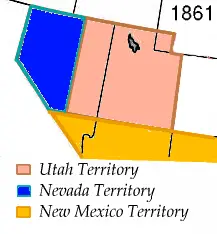 On March 2, 1861, the Nevada Territory separated from the Utah Territory and adopted its current name, shortened from Sierra Nevada (Spanish for "snowy range").
On March 2, 1861, the Nevada Territory separated from the Utah Territory and adopted its current name, shortened from Sierra Nevada (Spanish for "snowy range").
The separation of the territory from Utah was important to the federal government because of the Nevada population's political leanings, while the population itself was keen to be separated because of animosity (and sometimes violence) between mainstream Christians who dominated Nevada and the Mormons who dominated the rest of the Utah territory, especially after the Mountain Meadows massacre of 1857 and the Utah War in 1857-1858.
Statehood
In 1864, Nevada became the 36th state to enter the union, and the phrase "Battle Born" on the state flag reflects the state's entry on the Union side during the American Civil War. Eight days prior to the presidential election of 1864, Nevada became the 36th state in the union. Statehood was rushed to the date of October 31 to help ensure Abraham Lincoln's reelection on November 8 and post-Civil War Republican dominance in Congress.[4] As Nevada's mining-based economy tied it to the more industrialized Union, it was viewed as more politically reliable than other Confederate-sympathizing states such as neighboring California[citation needed]. This is only a widely accepted theroy.
Nevada achieved its current southern boundaries on May 5, 1866 when it absorbed the portion of Pah-Ute County in the Arizona Territory west of the Colorado River, essentially all of present day Nevada south of the 37th parallel. The transfer was prompted by the discovery of gold in the area, and it was thought by officials that Nevada would be better able to oversee the expected population boom. This area includes most of what is now Clark County.
In 1868 another part of the western Utah Territory, whose population was seeking to avoid Mormon dominance, was added to Nevada in the eastern part of the state, setting the current eastern boundary.
Industry
Mining shaped Nevada's economy for many years. When Mark Twain lived in Nevada during the period described in Roughing It, mining had led to an industry of speculation and immense wealth. However, both mining and population declined in the late 19th century. However, the rich silver strike at Tonopah in 1900, followed by strikes in Goldfield and Rhyolite, again put Nevada's population on an upward trend.
Gaming and labor
Unregulated gambling was common place in the early Nevada mining towns but outlawed in 1909 as part of a nation-wide anti-gaming crusade. Due to subsequent declines in mining output and the decline of the agricultural sector during the Great Depression, Nevada re-legalized gambling on March 19, 1931, with approval from the legislature. At the time, the leading proponents of gambling expected that it would be a short term fix until the state's economic base widened to include less cyclical industries. However, re-outlawing gambling has never been seriously considered since, and the industry has become Nevada's primary source of revenue today.
The Hoover Dam, located outside Las Vegas near Boulder City, was constructed in the years 1932–1935. Thousands of workers from across the country came to build the dam, and providing for their needs in turn required many more workers. The boom in population is likely to have fueled the re-legalization of gambling, alike present-day industry. Both Hoover Dam and later war industries such as the Basic Magnesium Plant first started the growth of the southern area of the state near Las Vegas. Over the last 75 years, Clark County has grown in relation to the Reno area, and today encompasses most of the state's population.
Nuclear Testing
The Nevada Test Site, 65 miles (105 km) Northwest of the City of Las Vegas, was founded on January 11, 1951 for the testing of nuclear weapons. The site is composed of approximately 1,350 square miles (3,500 km²) of desert and mountainous terrain. Nuclear testing at the Nevada Test Site began with a one-kiloton of TNT (4 terajoule) bomb dropped on Frenchman Flats on January 27, 1951. The last atmospheric test was conducted on July 17, 1962 and the underground testing of weapons continued until September 23, 1992. The location is known for the highest amount of concentrated nuclear detonated weapons in the U.S. It is also the home of Area 51.
Over 80% of the state's area is owned by the federal government. The primary reason for this is that homesteads were not permitted in large enough sizes to be viable in the arid conditions that prevail throughout desert Nevada. Instead, early settlers would homestead land surrounding a water source, and then graze livestock on the adjacent public land, which is useless for agriculture without access to water (this pattern of ranching still prevails). The deficiencies in the Homestead Act as applied to Nevada were probably due to a lack of understanding of the Nevada environment, although some firebrands (so-called "Sagebrush Rebels") maintain that it was due to pressure from mining interests to keep land out of the hands of common folk. This debate continues to be argued among some state historians today.
Demographics
According to the Census Bureau's 2007 estimate, Nevada has an estimated population of 2,565,382 which is an increase of 92,909, or 3.5%, from the prior year and an increase of 516,550, or 20.8%, since the year 2000. This includes a natural increase since the last census of 81,661 people (that is 170,451 births minus 88,790 deaths) and an increase due to net migration of 337,043 people into the state. Immigration from outside the United States resulted in a net increase of 66,098 people, and migration within the country produced a net increase of 270,945 people. According to the 2006 census estimate, Nevada is the country's second-fastest growing state.[5] Las Vegas was America's fastest-growing city and metropolitan area from 1960 to 2000, but has grown from a gulch of 100 people in 1900 to 10,000 by 1950 to 100,000 by 1970 to have 2.5 million in the metro area today.
According to the census estimates the racial distributions were as follows: 65% White American, 7.1% African-American, 6% Asian-American (estimates placed them at 10%), 2% others (American Indians and Pacific Islanders) and the remaining 20% were Hispanics or Latinos of any race.
Nevada also has a sizable Basque ancestry population. In Douglas and Pershing Counties, a plurality of residents are of Mexican ancestry with Clark County (Las Vegas) being home to over 200,000 Mexican Americans alone; Nye County and Humboldt County have a plurality of Germans; and Washoe County has many of Irish ancestry. Las Vegas is home to rapid-growing ethnic communities like Canadians, Scandinavians, Italians, Poles, American Jews and Armenians mainly are aging transplants from East Coast states has came to Las Vegas for retirement.
Largely African-American sections of Las Vegas ("the Meadows") and Reno can be found, but many African-Americans in Nevada are newly transplanted residents from either California and the East Coast, but the US Armed forces, hotels and domestic services attracted black Americans since the 1950s.
Since the California Gold Rush of the 1850s brought thousands of Chinese miners in Washoe county, Asian Americans lived in the state followed by few hundreds of Japanese farm workers in the late 1800s. In the late 20th century, many immigrants from China, Japan, Korea, Philippines and recently from India and Vietnam came to the Las Vegas metropolitan area with one of America's most prolific Asian-American communities, with a mostly Chinese and Taiwanese area known as "Chinatown" west of I-15 on Spring street, and an "Asiatown" shopping mall for Asian customers on Charleston Avenue/Paradise Boulevard.
According to the 2000 U.S. Census, 16.19% of the population aged 5 and over speak Spanish at home, while 1.59% speak Filipino [1] and 1% speak Chinese languages, the majority of foreign languages are found in ethnic sections of Central Las Vegas.
6.8% of its population were reported as under 5, 26.3% under 18, and 13.6% were 65 or older. Females made up approximately 50.7% of the population. As a result of its rapid population growth, Nevada has a higher percentage of residents born outside of the state than any other state. Las Vegas was a major destination for immigrants seeking employment by the gaming and hospitality industries from South Asia and Latin America during the 1990s and 2000s, but farming and construction is the biggest employer of immigrant labor.
From about the 1940s to 2003, Nevada was the fastest-growing state in the US percentage-wise. Between 1990 and 2000, Nevada's population increased 66.3%, while the USA's population increased 13.1%. Over two thirds of the population of the state live in the Las Vegas metropolitan area.
Religion
Major religious affiliations of the people of Nevada are:[6]
- Roman Catholic – 27%
- Protestant
- Mainline – 11%
- Evangelical – 13%
- Other Protestant – 2%
- Latter-day Saint/ Mormon – 11%
- Muslim – 2%
- Jewish – 1%
- Other Religions – 1%
- Unaffiliated – 20%
The largest denominations by number of adherents in 2000 were the Roman Catholic Church with 331,844; the Church of Jesus Christ of Latter-day Saints with 116,925; and the Southern Baptist Convention with 40,233. 77,100 Nevadans belong to Jewish congregations.[7]
Economy
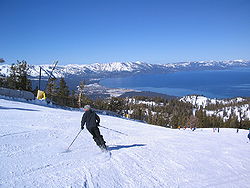
The Bureau of Economic Analysis estimates that Nevada's total state product in 2006 was $117 billion. Resort areas such as Las Vegas, Reno, Lake Tahoe, attract visitors from around the world. Per capita personal income in 2005 was $46,108, 11th in the nation. Its agricultural outputs are cattle, hay, alfalfa, dairy products, onions and potatoes. Its industrial outputs are tourism, mining, machinery, printing and publishing, food processing, and electric equipment. Prostitution is legal in parts of Nevada, in the form of brothels, but only counties with populations under 400,000 residents can legalize it, and even those counties may choose to outlaw it if they wish. Prostitution is illegal and offenders are prosecuted in Clark County (which contains Las Vegas), Washoe County (which contains Reno), and several other counties around the state.
In portions of the state outside of the Las Vegas and Reno metropolitan areas, mining and cattle ranching are the major economic activities. By value, gold is by far the most important mineral mined. In 2004, 6.8 million ounces of gold worth $2.84 billion were mined in Nevada, and the state accounted for 8.7% of world gold production (see Gold mining in Nevada). Silver is a distant second, with 10.3 million ounces worth $69 million mined in 2004 (see Silver mining in Nevada).[8] Other minerals mined in Nevada include construction aggregates, copper, gypsum, diotomite and lithium. Despite its rich deposits, the cost of mining in Nevada is generally high, and output is very sensitive to world commodity prices.
As of January 1, 2006 there were an estimated 500,000 head of cattle and 70,000 head of sheep in Nevada.[9] Most of these animals forage on rangeland in the summer, with supplemental feed in the winter. Calves are generally shipped to out-of-state feedlots in the fall to be fattened for market. Over 90% of Nevada's 484,000 acres (1,960 km²) of cropland is used to grow hay, mostly alfalfa, for livestock feed.
- Further information: Nevada locations by per capita income
Nevada is also one of only a few states with no personal income tax and no corporate income tax. The state sales tax in Nevada is 6.5%. Counties can assess option taxes as well, making the combined state/county sales taxes rate in some areas as high as 7.75%. Sales tax in Carson City is 7.125% in Clark County 7.75%, in Washoe County 7.375%, while sales tax in Douglas County is 6.75%.
Transportation
Amtrak's California Zephyr train uses the Union Pacific's original transcontinental railroad line in a daily service from Chicago to Emeryville, California serving Elko, Winnemucca, Sparks, and Reno. Amtrak Thruway Motorcoaches also provide connecting service from Las Vegas to trains at Needles, California, Los Angeles, and Bakersfield, California; and from Stateline, Nevada, to Sacramento, California.
Union Pacific Railroad has some railroads in the north and in the south. Greyhound Lines provides some bus services.
Interstate 15 passes through the southern tip of the state, serving Las Vegas and other communities. I-215 and spur route I-515 also serve the Las Vegas metropolitan area. Interstate 80 crosses through the northern part of Nevada, roughly following the path of the Humboldt River from Utah in the east and passing westward through Reno and into California. It has a spur route, I-580. Nevada also is served by several federal highways: US 6, US 50, US 93, US 95 and US 395. There are also 189 Nevada state highways. Nevada is one of a few states in the U.S. that does not have a continuous interstate highway linking its major population centers of Reno/Carson City and Las Vegas. Even the non-interstate federal highways aren't contiguous between its two largest metropolitan areas, though they are well marked by signs showing where to turn.
The state is one of just a few in the country that allow semi-trailer trucks with three trailers—what might be called a "road train" in Australia. However, American versions are usually smaller, in part because they must ascend and descend some fairly steep mountain passes.
Citizens Area Transit (CAT) is the public transit system in the Las Vegas metropolitan area. The agency is the largest transit agency in the state and operates a network of frequent bus service, including the use of double-decker buses on the Las Vegas Strip. RTC RIDE operates a system of local transit bus service throughout the Reno-Sparks metropolitan area. Other transit systems in the state include Carson City's JAC. Most other counties in the state do not have public transportation at all.
Additionally, a monorail system provides public transportation in the Las Vegas area. The Las Vegas Monorail line services several casino properties and the Las Vegas Convention Center on the east side of the Las Vegas Strip, with a possible future extension to McCarran Airport.
McCarran International Airport in Las Vegas is one of the busiest airports in the nation. The Reno-Tahoe International Airport (formerly known as the Reno Cannon International Airport) is the other major airport in the state.
Law and government
The current Governor of Nevada is Jim Gibbons (Republican), the Governor of Nevada is limited to two (four year) terms in office, by election, or succession (lifetime limit) by the Nevada Constitution. Nevada's two U.S. senators are Harry Reid (Democrat) and John Ensign (Republican).
Legislature
The Nevada Legislature is a bicameral body divided into an upper house Senate and a lower house Assembly. Members of the Senate serve for four years, and members of the Assembly serve for two years. Both houses of the Nevada Legislature will be impacted by term limits starting in 2010, as Senators and Assemblymen/women will be limited to a maximum of 12 years service in each house (by appointment or election which is a lifetime limit) - this provision in the constitution was recently upheld for legislators by the Supreme Court of Nevada in a unanimous decision (7-0), so term limits will be in effect starting in 2010. Each session of the Legislature meets for a constitutionally mandated 120 days in every odd-numbered year, or longer if the Governor calls a special session. Currently, the Senate is controlled by the Republican Party (11 to 10 majority) and the Assembly is controlled by the Democratic Party (27 to 15 majority).
Judiciary
Nevada is one of the few U.S. states without a system of intermediate appellate courts. It has a state supreme court, the Supreme Court of Nevada, which hears all appeals. The court lacks the power of discretionary review, so Nevada's judicial system is extremely congested. There have been several articles accusing judges in Nevada of making biased or favored decisions as the result of case outcomes and reporting done by the Los Angeles Times newspaper (in which it raised the issue of justice for sale).
Original jurisdiction is divided between the District Courts (with general jurisdiction), and Justice Courts and Municipal Courts (both of limited jurisdiction).
Libertarian laws
In 1900, Nevada's population was the smallest of all states and was shrinking, as the difficulties of living in a "barren desert" began to outweigh the lure of silver for many early settlers. Historian Lawrence Friedman has explained what happened next:
- Nevada, in a burst of ingenuity, built an economy by exploiting its sovereignty. Its strategy was to legalize all sorts of things that were illegal in California ... after easy divorce came easy marriage and casino gambling.
Even prostitution is legal in Nevada (under the form of licensed brothels) in most rural counties (it is however illegal in Clark County, which contains Las Vegas, in Washoe County, which contains Reno, in Carson City, and in two other counties).
Divorce laws
Nevada's early reputation as a "divorce haven" arose from the fact that, prior to the no-fault divorce revolution in the 1970s, divorces were quite difficult to obtain in the United States. Already having legalized gambling and prostitution, Nevada continued the trend of boosting its profile by adopting one of the most liberal divorce statutes in the nation. This resulted in Williams v. North Carolina, , in which the U.S. Supreme Court ruled that North Carolina had to give "full faith and credit" to a Nevada divorce. (This basically means all states have to honor a marriage or divorce performed in another state.)
Tax laws
Nevada's tax laws also draw new residents and businesses to the state. Nevada has no personal income tax or corporate income tax. [2].
Incorporation laws
Nevada also provides friendly environment for the formation of corporations, and many (especially California) businesspeople have incorporated their businesses in Nevada to take advantage of the benefits of the Nevada statute. Nevada Corporations offer great flexibility to the Board of Directors and simplify or avoid many of the rules that are cumbersome to business managers in some other states. In addition, Nevada has no franchise tax.
Financial institutions
Similarly, many U.S. states have usury laws limiting the amount of interest a lender can charge, but Federal law allows corporations to 'import' these laws from their home state. Nevada (amongst others) has relatively lax interest laws, in effect allowing banks to charge as much as they want, hence the preponderance of credit card companies in the state.
Drug and alcohol laws
This is a notable exception to Nevada's otherwise libertarian principles. It is notable for having the harshest penalties for drug offenders in the country. Nevada remains the only state to still use mandatory minimum sentencing guidelines for marijuana possession. However, it is now a misdemeanor for possession of less than one ounce. In 2006, voters in Nevada defeated attempts to allow possession of 1 ounce of marijuana (for personal use) without being criminally prosecuted, (55% against legalization, 45% in favor of legalization). Also, Nevada is one of the states that allows for use of marijuana for medical reasons (though this remains illegal under federal law).
Nevada has very liberal alcohol laws. Bars are permitted to remain open 24 hours, with no "last call." Liquor stores, convenience stores and supermarkets may also sell alcohol 24 hours per day, and may sell beer, wine and spirits.
Smoking
Nevada voters enacted a smoking ban ("the Nevada Clean Indoor Air Act") in November 2006 that became effective on December 8, 2006. It outlaws smoking in most workplaces and public places. Smoking is permitted in bars, but only if the bar serves no food, or the bar is inside a larger casino. Smoking is also permitted in casinos, hotel rooms, tobacco shops, and brothels.[10] However, some businesses do not obey this law and the government tends not to enforce it.[11] Yet, in one case they did prosecute an establishment called "Bilbo's" but trial is pending until 2008.[12]
Politics
| Year | Republican | Democratic |
|---|---|---|
| 2004 | 50.47% 418,690 | 47.88% 397,190 |
| 2000 | 49.49% 301,575 | 45.94% 279,978 |
| 1996 | 44.55% 198,775 | 45.60% 203,388 |
| 1992 | 34.71% 175,828 | 37.41% 189,148 |
| 1988 | 58.90% 206,040 | 37.91% 132,738 |
Due to the growth of Las Vegas in recent years, there is a noticeable divide between politics of northern and southern Nevada. The north has long maintained control of key positions in the state government even while the population of the Las Vegas area is larger than the rest of the state. This has fostered resentment as the north sees the south as a potential bully of majority rule (and a leech on its resources, mainly water and electricity) and the south sees the north as the "old guard" trying to rule as an oligarchy. However, due to a term limit amendment passed by Nevada voters in 1994, and again in 1996, some of the North's hold over key positions will soon be forfeited to the South, leaving Northern Nevada with less power. Most people outside the state are not familiar with this rivalry.
Clark and Washoe counties—home to Las Vegas and Reno respectively—have long dominated the state's politics. Between them, they cast 87 percent of Nevada's vote, and elect a substantial majority of the state legislature. The great majority of the state's elected officials are either from Las Vegas or Reno.
Registration is nearly evenly split between the two major parties. According to official statistics, 38.1% of voters are registered Republicans, 41.7% are Democrats and the remaining 20.1% are considered Independents. As a result, Nevada remains a swing state in both state and federal politics. Democrat Bill Clinton won the state in the 1992 and 1996 presidential elections and Republican George W. Bush won in 2000 and 2004.
The state's U. S. Senators are Democrat Harry Reid, the Senate Majority Leader, and Republican John Ensign, chairman of the National Republican Senatorial Committee. Both are from Las Vegas. The Governorship is held by Jim Gibbons, a Republican from Reno.
State departments and agencies
- Attorney General
- Department of Business & Industry
- Department of Conservation & Natural Resources
- Consumer Health Assistance
- Controller's Office
- Department of Correction
- Department of Cultural Affairs
- Nevada Commission on Economic Development
- Department of Education
- Nevada Secretary of State, Election Division
- Department of Employment, Training & Rehabilitation
- Gaming Control Board
- Governor's Office
- Department of Health and Human Services
- Department of Information Technology
- Department of Justice
- Lieutenant Governor
- Nevada Military Department
- Division of Minerals, Commission on Mineral Resources
- Department of Motor Vehicles
- Nevada National Guard
- Department of Personnel
- Advisory Council for Prosecuting Attorneys
- Public Employees Benefit Program
- Public Employees Retirement System
- Department of Public Safety
- Public Utilities Commission
- Department of Secretary of State
- Department of Taxation
- Commission on Tourism
- Department of Transportation
- Nevada State Treasurer
- Universities and Community Colleges of Nevada
- Nevada Office of Veterans' Services
- Western Interstate Commission for Higher Education
- Nevada Department of Wildlife
Local government
Incorporated towns in Nevada, known as cities, are vested with home rule powers, meaning that they are given the authority to legislate anything not prohibited by law.
Unincorporated towns are settlements eminently governed by the county in which they are located, but who, by local referendum or by the act of the county commission, can form limited local governments in the form of a Town Advisory Board (TAB)/ Citizens Advisory Council (CAC), or a Town Board.
Town Advisory Boards and Citizens Advisory Councils are formed purely by act of the county commission. Consisting of three to five members, these elected boards form a purely advisory role, and in no way diminish the responsibilities of the county commission that creates them. Members of advisory councils and boards are elected to two year terms, and serve without compensation. The councils and boards, themselves, are provided no revenue, and oversee no budget.
Town Boards are limited local governments created by either the local county commission, or by referendum. The board consists of five members elected to four-year terms. Half the board is required to be up for election in each election. The board elects from within its ranks a town chairperson and town clerk. While more powerful than Town Advisory Boards and Citizens Advisory Councils, they also serve a largely advisory role, with their funding provided by their local county commission. The local county commission has the power to put before residents of the town a vote on whether to keep or dissolve a town board at any general election. Town boards have the ability to appoint a town manager if they choose to do so.
Important Cities and Towns
|
Paradise, Sunrise Manor, and Spring Valley are unincorporated towns in the Las Vegas metropolitan area.
| Rank | County | Population within county limits |
Land Area sq. miles |
Population Density per sq mi |
Largest city |
|---|---|---|---|---|---|
| 1 | Clark | 1,715,337 | 7,910 | 174 | Las Vegas |
| 2 | Washoe | 383,453 | 6,342 | 54 | Reno |
| 3 | Carson City | 56,146 | 155.7 | 366 | Carson City |
| 4 | Douglas | 47,803 | 710 | 58 | Gardnerville Ranchos |
| 5 | Elko | 46,499 | 17,179 | 3 | Elko |
| 6 | Lyon | 44,646 | 1,994 | 17 | Fernley |
| 7 | Nye | 38,181 | 18,147 | 2 | Pahrump |
| 8 | Churchill | 26,106 | 4,929 | 5 | Fallon |
| 9 | Humboldt | 17,129 | 9,648 | 2 | Winnemucca |
| 10 | White Pine | 8,966 | 8,876 | 1 | Ely |
Note: table was compiled using Nevada State estimates from 2004 for population and Census 2000 for area and density
10 richest places in Nevada
Ranked by per capita income
- Incline Village-Crystal Bay $52,521
- Kingsbury $41,421
- Mount Charleston $38,821
- Verdi-Mogul $38,233
- Zephyr Cove-Round Hill Village $37,218
- Summerlin South $33,017
- Blue Diamond $30,479
- Minden $30,405
- Boulder City $29,770
- Spanish Springs $26,908
- [[honorable mention RENO
- Further information: Nevada locations by per capita income
Education
Colleges and universities
- Nevada System of Higher Education
- University of Nevada, Reno (UNR)
- University of Nevada, Las Vegas (UNLV)
- Nevada State College
- Truckee Meadows Community College (TMCC)
- Great Basin College
- College of Southern Nevada (CSN)
- Western Nevada College
- Sierra Nevada College
- Touro University Nevada
- University of Southern Nevada
Research Institutes
- Desert Research Institute
Parks and Recreation
.
Recreation areas maintained by the National Park Service
- California National Historic Trail
- Death Valley National Park
- Great Basin National Park near Baker
- Lake Mead National Recreation Area
- Old Spanish National Historic Trail
- Pony Express National Historic Trail
Southern Nevada
- Mount Charleston and the Mount Charleston Wilderness Area
- Spring Mountains and the Spring Mountains National Recreation Area
- Humboldt-Toiyabe National Forest
- Bootleg Canyon Mountain Bike Park
- Ash Meadows National Wildlife Preserve
Wilderness
- Further information: List of wilderness areas in Nevada
There are 68 designated wilderness areas in Nevada, protecting some 6,579,014 acres (26,624.33 km²) under the jurisdiction of the National Park Service, U.S. Forest Service, and Bureau of Land Management.[13]
State Parks
See: List of Nevada state parks.
Sports
- Las Vegas 51s, minor league baseball
- Las Vegas Wranglers, East Coast Hockey League
- Battle Born Derby Deamons, Roller Derby
- Reno Aces, minor league baseball
- Reno Silver Sox, Golden Baseball League
- Reno Raiders, ECHL
- Las Vegas Posse, Canadian Football League (defunct)
- Las Vegas Outlaws, XFL (defunct)
- UNLV Rebels
- University of Nevada Wolf Pack
- Las Vegas Motor Speedway
Miscellaneous topics
Nevada's nicknames are "Sagebrush State, "Battle Born State," and "Silver State."
Several United States Navy ships have been named USS Nevada in honor of the state. The one that preceded the ship that was at Pearl Harbor was eventually renamed USS Tonopah, for the Nevada city
Nevada is home to Nellis Air Force Base, a major testing and training base of the United States Air Force. Nellis is reputedly the home of Area 51, a top-secret installation of which the U.S. federal government has always denied existence. Area 51 is supposedly located in Groom Lake. Some time ago, the United States Air Force confirmed that there is an operating facility at Groom Lake, but the nature of the activities being conducted at Groom Lake are classified and cannot be disclosed.
Looking to the future
Nevada enjoys many economic advantages as a whole, and the southern portion of the state enjoys mild winter weather, but rapid growth has led to issues of overcrowded schools. Nevada is already home to the nation's 5th largest school district in the Clark County School District (projected fall 2007 enrollment is 314,000 students grades K-12), the state has seen rising crime levels, and problems with transportation (according to state figures, there is a 1 billion dollar shortfall in funds for road construction projects in Nevada). Most recently, there has been news of water shortfalls in Southern Nevada in the years to come, due to the population increase, and the Southern Nevada Water Authority estimates that there will be water shortages by the year 2010, despite plans to import water from rural and northern Nevada. Despite this, the state remains one of the fastest growing in the country.
The residents of the communities in the Las Vegas Valley pay some of the highest car insurance rates in the nation.
Some have suggested that Nevada annex the town of Wendover, Utah, which would be merged with West Wendover, Nevada. This deal will require the permission of the Nevada and Utah legislatures, as well as the U.S. Congress.
In 2008, The American State Litter Scorecard, presented at the American Society for Public Administration national conference, positioned Nevada, next to Mississippi and Louisiana, one of the worst states for removing litter from public roadways and properties. [citation needed]
Recently, an economic downturn due to the house market collapse in Las Vegas (which has one of the highest home foreclosure rates in the nation), coupled with many months of declining gaming revenue and higher prices for gasoline and consumer goods has caused a 1.2 billion dollar shortfall in the state budget (which is required by the constitution to be balanced), and has caused Nevada to drain its rainy day fund of 267 million coupled with budget cuts means that hard times are ahead for the Silver state. In August 2008, it was announced that Boyd Gaming would halt construction on a 4.2 billion dollar project called Echelon, which was to replace the old Stardust Hotel & Casino, the reason cited for this is lack of funding/credit from banks, and a souring economy.
State symbols
areas of Nevada
- State animal: Desert Bighorn Sheep
- State artifact: Tule Duck Decoy
- State bird: Mountain Bluebird
- State colors: Silver and Blue
- State fish: Lahontan cutthroat trout
- State flower: Sagebrush (Artemisia tridentata)
- State fossil: Ichthyosaur
- State grass: Indian ricegrass
- State march: "Silver State Fanfare" by Gerald Willis
- State metal: Silver (Ag)
- State motto: "Battle Born"
- State precious gemstone: Virgin Valley black fire opal
- State semiprecious gemstone: Nevada turquoise
- State song: "Home Means Nevada" by Bertha Raffetto
- State reptile: Desert Tortoise
- State rock: Sandstone
- State soil: Orovada (soil) series
- State tartan: A particular tartan designed for Nevada by Richard Zygmunt Pawlowski
- State trees: Single-leaf Pinyon pine and Bristlecone pine (Pinus longaeva)
A fictional history (with a great deal of fact) titled Nevada was written by Clint McCullough.
Notes
- ↑ Nevada Natural Resources Status Report
- ↑ Popul of Nevada's Counties and Incorp cities 2006 Time Series EMAIL 012207.xls
- ↑ National Climatic Data Center, Asheville, N.C., and Storm Phillips, STORMFAX, INC.
- ↑ Rocha Guy, Historical Myth a Month: Why Did Nevada Become A State?
- ↑ CNN
- ↑ Pew Forum on Religion & Public Life
- ↑ http://www.thearda.com/mapsReports/reports/state/32_2000.asp
- ↑ Nevada Mining Association, Economic Overview of the Nevada Mining Industry 2004
- ↑ United States Department of Agriculture Nevada State Agriculture Overview - 2005
- ↑ State smoking ban sparks zone-change request for Gardnerville parcel Nevada Appeal serving Carson City, Nevada
- ↑ Have Nevada bars given up the smoking habit?
- ↑ Las Vegas Now - Breaking News, Local News, Weather, Traffic, Streaming Video, Classifieds, Blogs - UPDATED: Bilbo's Smoking Lawsuit Case
- ↑ Wilderness.net
ReferencesISBN links support NWE through referral fees
External links
- Official state website
- Nevada State Databases - Annotated list of searchable databases produced by Nevada state agencies and compiled by the Government Documents Roundtable of the American Library Association.
- State Tourism website
- Nevada state symbols
- Secretary of State of Nevada
- Nevada State Library and Archives
- Energy Profile for Nevada
- USGS real-time, geographic, and other scientific resources of Nevada
- US Census Bureau
- County Maps of Nevada Full color maps. List of cities, towns and county seats
- Nevada State Facts
- Pronunciation Guide: Nevada
- Forgotten Nevada - Ghost Towns and Mining Camps of Nevada
- Nevada's Historical Markers
- {{{2}}} at the Open Directory Project
Coordinates:
Credits
New World Encyclopedia writers and editors rewrote and completed the Wikipedia article in accordance with New World Encyclopedia standards. This article abides by terms of the Creative Commons CC-by-sa 3.0 License (CC-by-sa), which may be used and disseminated with proper attribution. Credit is due under the terms of this license that can reference both the New World Encyclopedia contributors and the selfless volunteer contributors of the Wikimedia Foundation. To cite this article click here for a list of acceptable citing formats.The history of earlier contributions by wikipedians is accessible to researchers here:
The history of this article since it was imported to New World Encyclopedia:
Note: Some restrictions may apply to use of individual images which are separately licensed.
